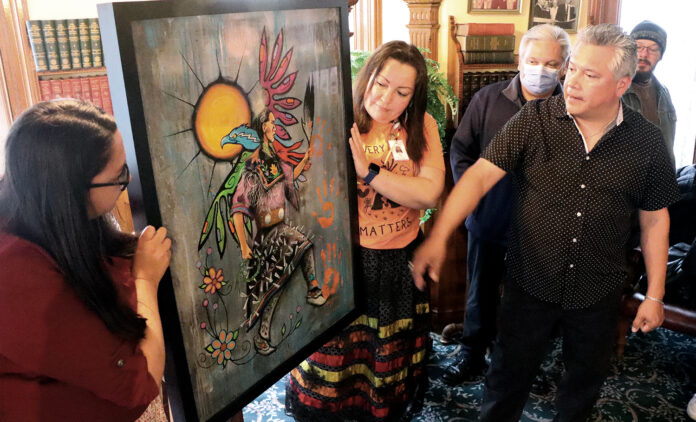
John Williams has been told his artwork gives comfort to members of his community using Bluewater Health.
The Aamjiwnaang First Nation artist was in Petrolia Friday unveiling Children of the Thunderbird, the second part of an installation commissioned by Bluewater Health as part of its commitment to Truth and Reconciliation.
Patients arriving at the ER at Charlotte Eleanor Englehart Hospital will see the jingle bell dancer with the Thunderbird on her back. Williams says the jingle bell skirt is made up of 365 tin cones which are like “every day of the year making a song.” Jinglebell dancers carry prayers, he added. The artwork includes orange hand prints honouring the children who were taken to residential schools and the signatures of Williams’ son and cousin, Charlotte, who helped with the work.
Paula Reaume-Zimmer, CEO of Bluewater Health says the work “it demonstrates the beauty but … when we hear the description of the artwork it reminds us of the devastating health inequities that the Indigenous individuals have have endured” adding “We know that our Indigenous patients want access to culturally-safe care without discrimination. And as a leader, I’m very committed to upholding that.”
Williams told the 20 people gathered at the unveiling at the hospital’s historic Corey Room, he has seen the restorative power the artwork has on Indigenous people seeking health care. Two years ago, he and Hamilton muralist Andrea Manica created a work which greets people coming to the Withdrawal Management Unit. Recently a friend told him he had seen it as he sought treatment.
“He was heading up, the staff using a wheelchair, he was a little on edge, you know, a little antsy…later he said ‘when the doors open, and I saw that,’ he goes ‘I knew I was in the right place because everything just went easy – kind of levelled out and you felt good about being there.’”
Williams his work “feels like giving back” to his community and he’s proud to acknowledge and honour the memory of those who were forced into the residential school system.




